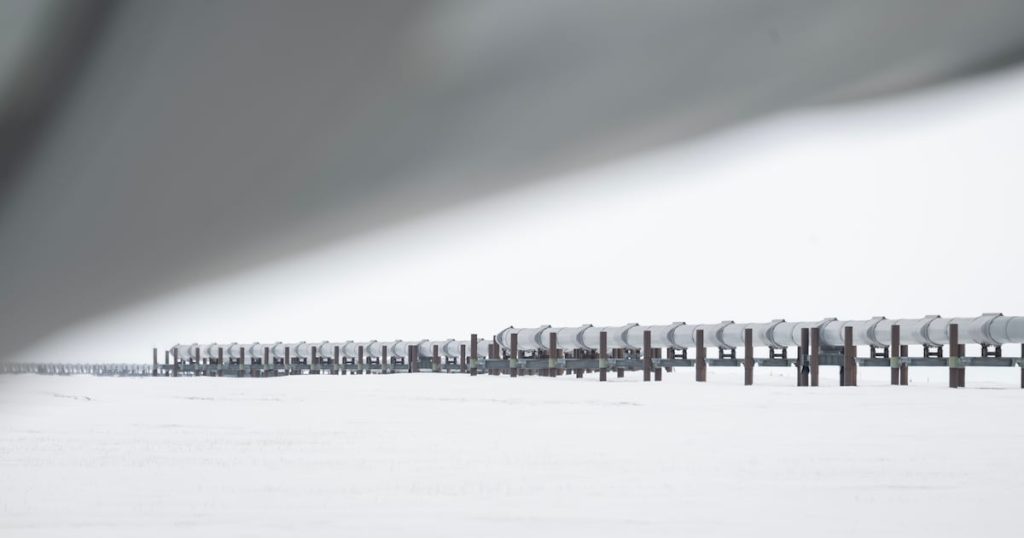Sure! Here’s a paraphrased version of the article structured into HTML format with headings and around seven paragraphs.
<div>
<figure class="c-media-item">
<img
alt=""
class="c-image"
loading="lazy"
src="https://www.adn.com/resizer/v2/DDTBL2ODA5HWVBBMD2MQQUH7FA.JPG?auth=be6a62a5716516d4ce9d7b18bd556556b65d20328c250e0d3ce845580e573788&width=800&height=533"
width="800"
height="533"/>
<figcaption class="c-media-item__fig-caption">
<span class="c-media-item__caption">
The trans-Alaska pipeline extends from Pump Station 1 in Prudhoe Bay on June 2, 2025. Along the pipeline runs a smaller-diameter natural gas line used to fuel the oil pipeline's pumps. That small-diameter line could be a source of fuel for a new bitcoin mining operation on the North Slope. (Marc Lester / ADN)
</span>
</figcaption>
</figure>
<h1>Proposed Bitcoin Mining Operation on Alaska's North Slope</h1>
<p>A startup firm plans to establish a major bitcoin mining operation on Alaska’s North Slope, which is anticipated to utilize the region's plentiful natural gas. The initiative aims to become the largest bitcoin mining project in the U.S.</p>
<h2>Ambitious Plans</h2>
<p>Stax Capital Partners, based in Wasilla, intends to create a blueprint for sustainable large-scale bitcoin mining in Alaska, according to CEO Sparrow Mahoney. She believes Alaska is uniquely positioned for such an endeavor in the long term.</p>
<h2>Permitting and Setup</h2>
<p>The company has applied for a permit to install shipping container-like units equipped with natural gas generators and computing systems about 30 miles south of the expansive Prudhoe Bay oil field. The gas supply will come from substantial reserves of “stranded” natural gas in the area that currently lack pipeline access.</p>
<h2>Digital Mining Process</h2>
<p>Unlike traditional hard rock mining, bitcoin mining is a digital operation that relies entirely on computers to create cryptocurrency. Despite this, the surge of bitcoin mining facilities is meeting increasing public resistance over their energy consumption and land use, particularly in lower 48 states.</p>
<h2>Challenges Ahead</h2>
<p>While Alaska lawmakers are promoting the state's unutilized land and the potential to harness stranded gas, the remote location and high construction costs make developing new industries challenging. Furthermore, oil companies have not historically sold significant gas supplies for such operations, raising concerns about whether costs can be managed effectively.</p>
<h2>Project Scale</h2>
<p>Stax's generators could produce up to 50 megawatts of electricity, comparable to Alaska's largest coal power plant. Currently, the company is in discussions with various potential gas suppliers on the North Slope but has yet to finalize any agreements.</p>
<h2>Future Aspirations</h2>
<p>The goal is to begin construction by late 2025. If successful, the initial project may expand to generate up to a gigawatt of power, significantly larger than the initial development. Mahoney emphasizes the project's potential benefits to Alaska, suggesting that there’s a substantial economic opportunity rooted in existing infrastructure and resources.</p>
<p><i>Nathaniel Herz is an Anchorage-based reporter. Subscribe to his newsletter, </i><a href="https://www.northernjournal.com/new-alaska-bitcoin-mine-would-use-as-much-power-as-the-states-largest-coal-plant-produces/" title="https://www.northernjournal.com/new-alaska-bitcoin-mine-would-use-as-much-power-as-the-states-largest-coal-plant-produces/"><i>Northern Journal</i></a><i>, at </i><a href="https://www.northernjournal.com/"><i>northernjournal.com</i></a><i>.</i></p>
</div>This structure preserves the core information while rephrasing it and organizing it into appropriate sections.



